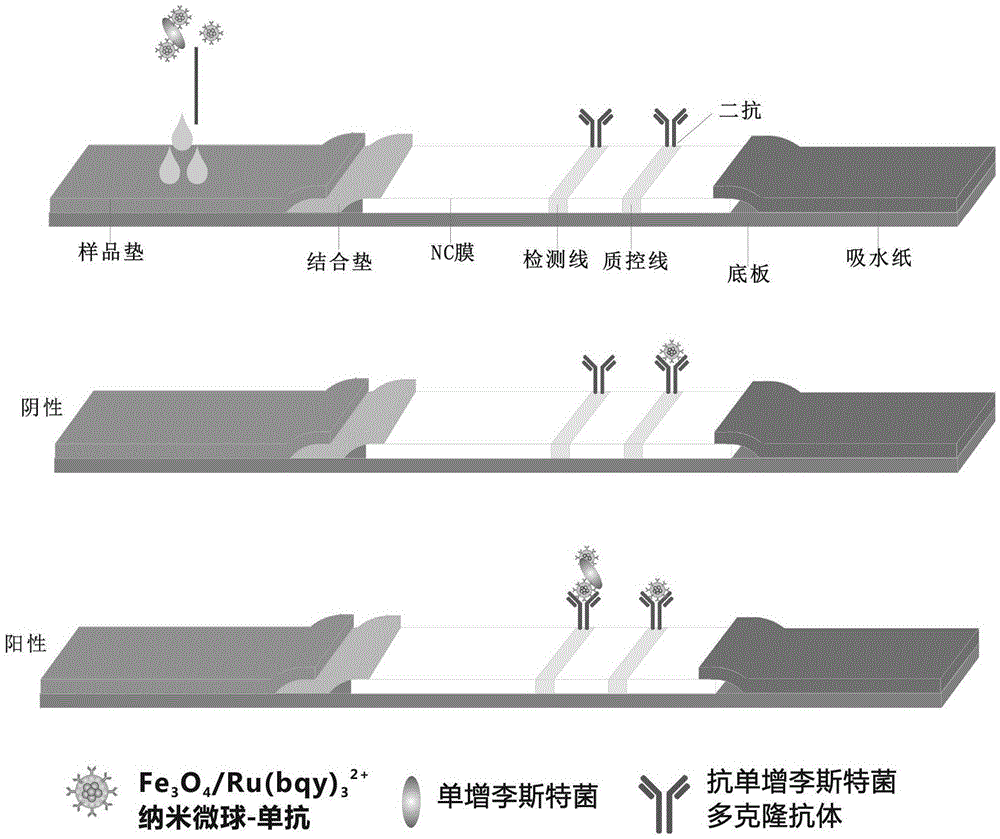Method for fast detecting Listeria monocytogenes
A fast technology for Listeria monocytogenes, applied in the field of microbial detection, can solve the problems of limited colloidal gold optical signal, limited application, low sensitivity of colloidal gold immunochromatography test strips, etc., to improve detection sensitivity and reduce workload , Uniform immunological response
- Summary
- Abstract
- Description
- Claims
- Application Information
AI Technical Summary
Problems solved by technology
Method used
Image
Examples
Embodiment 1
[0039] Embodiment one: using Fe 3 o 4 / Ru(bqy) 3 2+ Detection of Listeria monocytogenes in milk by nano-microsphere immunochromatographic test strips
[0040] 1. Preparation of Fc-conjugated mAbs 3 o 4 / Ru(bqy) 3 2+ Nanospheres
[0041] 1.1 Fe 3 o 4 / Ru(bqy) 3 2+ Preparation of nanospheres: adding 0.6mmolFeCl 3 ·6H 2 O and 0.3 mmol FeCl 2 4H 2 O into 100mL of deionized water, nitrogen gas was passed into the solution and heated to 90°C, and then 4.7mL of 25% NH 3 ·H 2 O was added to the mixture and reacted for 2h. Use a permanent magnet to separate the black solid matter from the reaction solution and wash it with high-purity water for 3 to 5 times to obtain Fe 3 o 4 Nanoparticles; take 12mg Fe 3 o 4 Nanoparticles were resuspended with a mixture of 3mL deionized water and 20mL ethanol, and 0.5mL of NH 4 OH solution, then dissolve 50uL tetraethyl orthosilicate in 50uL ethanol solution and add dropwise, react at room temperature for 12h, in Fe 3 o 4 A lay...
Embodiment 2
[0051] Embodiment two: using Fe 3 o 4 / Ru(bqy) 3 2+ Detection of Listeria monocytogenes in beef by nano-microsphere immunochromatographic test strips
[0052] 1. Preparation of Fc-conjugated mAbs 3 o 4 / Ru(bqy) 3 2+ Nanospheres
[0053] 1.1Fe 3 o 4 / Ru(bqy) 3 2+ Preparation of nanospheres: adding 0.6mmolFeCl 3 ·6H 2 O and 0.3 mmol FeCl 2 4H 2 O into 100mL of deionized water, nitrogen gas was passed into the solution and heated to 90°C, and then 4.7mL of 25% NH 3 ·H 2 O was added to the mixture and reacted for 2h. Use a permanent magnet to separate the black solid matter from the reaction solution and wash it with high-purity water for 3 to 5 times to obtain Fe 3 o 4 Nanoparticles; take 12mg Fe 3 o 4 Nanoparticles were resuspended with a mixture of 3mL deionized water and 20mL ethanol, and 0.5mL of NH 4 OH solution, then dissolve 50uL tetraethyl orthosilicate in 50uL ethanol solution and add dropwise, react at room temperature for 12h, in Fe 3 o 4 A laye...
PUM
 Login to View More
Login to View More Abstract
Description
Claims
Application Information
 Login to View More
Login to View More - R&D
- Intellectual Property
- Life Sciences
- Materials
- Tech Scout
- Unparalleled Data Quality
- Higher Quality Content
- 60% Fewer Hallucinations
Browse by: Latest US Patents, China's latest patents, Technical Efficacy Thesaurus, Application Domain, Technology Topic, Popular Technical Reports.
© 2025 PatSnap. All rights reserved.Legal|Privacy policy|Modern Slavery Act Transparency Statement|Sitemap|About US| Contact US: help@patsnap.com

